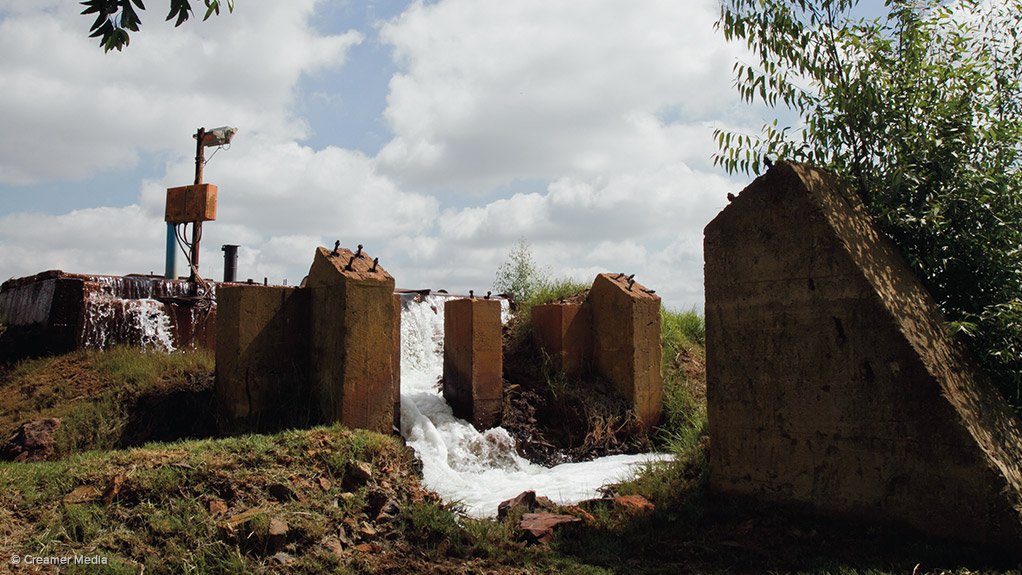South Africa-focused tailings extractor Mintails is implementing a long-term, sustainable solution to the prevailing problem of acid mine drainage (AMD) on Johannesburg’s West Rand, said Mintails operations GM Jan Jacobs at a media briefing held last month.
Jacobs addressed members of the media during a site visit to its operations on the West Rand of the Witwatersrand basin, near Krugersdorp.
He mentioned that Mintails had demonstrated the manageability of AMD in South Africa, that it had harnessed its understanding of the chemistry of AMD and that it had found ways to neutralise contaminated water to use it as process water.
The ASX-listed company deals with the rehabilitation of mine-impacted land and aquatic ecosystems.
With the help of water resource management specialist Dr Anthony Turton, Mintails is working on partnering with government to implement management interventions that will address AMD on the West Rand.
Turton has been helping Mintails develop innovative solutions for the safe closure of mine operations that involve the remediation of pollution plumes associated with mine dumps.
“By applying a virtual cycle model to the practice of mine closures, Mintails can be a custodian and a player in the rehabilitation of mining-impacted ecosystems,” said Turton, who was also at the media briefing.
Jacobs added that Mintails was developing a water policy in conjunction with the testing of the Beta Standard from the Alliance for Water Stewardship.
The standard aims to drive water stewardship, which is the use of water that is socially equitable, environmentally sustainable and economically beneficial.
The company is also in talks with government over the potential use of Mintails’ patented tailings water treatment technology, which will be used to neutralise AMD at a level considered safe for use in a desalination plant. “To treat the water to a safe drinking standard would not be financially viable, so we are focusing on recycling water for commercial applications,” said Jacobs.
Mintails has commissioned a water treatment plant capable of neutralising up to 40-million litres a day. The output of this plant is undergoing water-quality tests to prove compliance with strict regulatory requirements, which have been set out to ensure that the quality and quantity of water is sufficient. “Once this compliance has been demonstrated to a regulatory authority, the plant will be brought on line,” said Jacobs.
He added that this would align the AMD in the mine void with environmental conservation law guidelines within 36 months, thereby meeting regulatory objectives for AMD mitigation.
Turton mentioned that the process would have considerable advantages, as it would open up underground mining resources that are currently flooded. “In addition, it will provide government with a low-cost, higher- employment solution, which is defendable to the taxpaying public,” added Jacobs.
Mintails’ Technology
Mintails has developed proprietary technology to decontaminate underground water, which forms the basis of its water treatment plan. For its operations, the company uses water from the West Rand underground aquifer, which is historically severely acidic and radioactive.
The decontamination process involves cleaning water to create ‘grey’ water, which is not potable, but fit for industrial use. This water can be used for operational processes and, when discarded, is pumped back into tailings dams, which significantly raises pH levels and reduces the water’s corrosion potential.
“With the continuous reuse of this water, its level of toxicity will be lowered, over time, and it will be safer for industrial use than what it currently is,” said Jacobs.
He further highlighted that Mintails emphasised public and community engagement. “The company has established a forum for engagement with the public to facilitate public participation in the progress of the environmental management of the region.”
“The company engages with all parties affected by Mintails’ mining operations. It has, there-fore, established a database of interested and affected parties, as well as interest groups and a steering committee. Mintails has also provided a platform for public comment and the sharing of information, issues and concerns,” says Jacobs.
He added that Mintails was committed to being a good corporate citizen and to working in partnership with the regulatory authorities, environmental nonprofit organisations and civil society in trying to find solutions to South Africa’s national water problems.
Jacobs highlighted that Mintails was the first South African mining company to cooperate with the Alliance for Water Stewardship for the benchmarking of its water management.
Moving Forward
Turton mentioned that Mintails was considering the possibility of transforming surface tailings dumps into alternative energy platforms. “We are exploring the option of using the available space for either solar or wind farms, which will be capable of generating revenues to pay for the sustainable rehabilitation of the unique mining landscape,” he said.
Turton explained that establishing a wind farm on top of the rehabilitated West Wits pit, west of Johannesburg, originally mined by DRDGold in the 1980s, was being considered. “The technical viability of such an approach is currently at the prefeasibility stage and preliminary technical work has been initiated to investigate the viability of such a green solution,” concluded Turton.
About Mintails The Mintails name is taken from the direct description of its mining activities – mining of tailings.
The company started in 2006 when it successfully took Mogale Gold mine out of judicial management and recapitalised the company. Mintails has also acquired a share in the DRDGold/Ergo project, on Johannesburg’s East Rand.
It has developed a uranium and sulphuric acid production plant at the Mogale mining complex.
Mintails has also established several new exploration companies, such as one for the acquisition of exploration company West Wits Mining in May 2012, which has enabled Mintails to mine subsurface reef resources around the Randfontein Cluster of surface dumps.
Edited by: Samantha Herbst
Creamer Media Deputy Editor
EMAIL THIS ARTICLE SAVE THIS ARTICLE
To subscribe email subscriptions@creamermedia.co.za or click here
To advertise email advertising@creamermedia.co.za or click here













